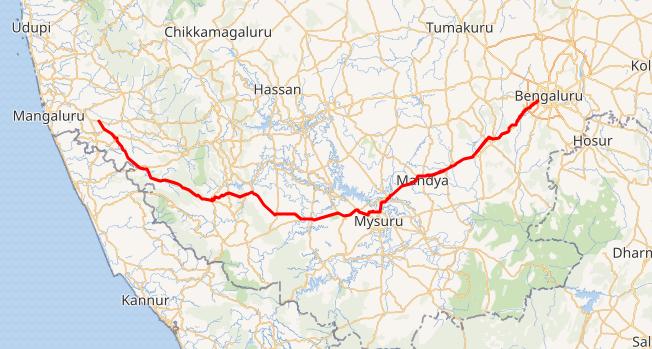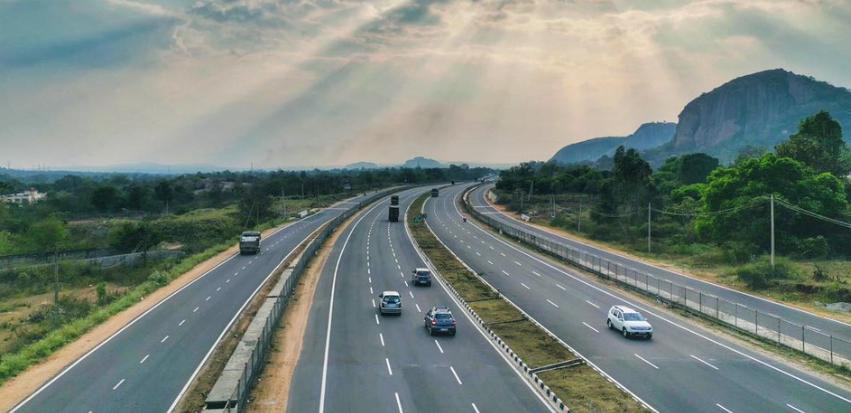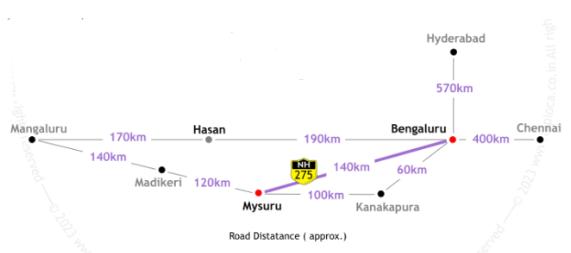




Table of Contents
- Project Overview
- Construction Phases and Milestones
- Impact on Travel Time and Economic Growth
- Status Update
- Conclusion
- Faq's
Project Overview
The Bengaluru to Mysuru, Access Controlled Expressway, designated as National Highway 275 (NH 275), serves as a lifeline connecting two major cities in Karnataka, India. Spanning a distance of 119 kilometers, this expressway forms a crucial segment of the Bengaluru to Mangaluru Economic Corridor (EC 34), facilitating seamless travel and fostering economic development along its route. Let's delve into the details of this transformative infrastructure project and its journey from inception to inauguration. NH 275, will be a modern marvel of engineering designed to enhance connectivity and reduce travel time between Bengaluru and Mysuru. With a total of 10 lanes, including an elevated access-controlled carriageway, this expressway offers a smooth and efficient commute for travelers.
 Bengaluru to Mangaluru Economic Corridor
Bengaluru to Mangaluru Economic Corridor
Construction Phases and Milestones
The construction of the Bengaluru to Mysuru Expressway is executed in two phases.
Phase 1, spanning 56 kilometers, connects Bengaluru to Nidaghatta.
Phase 2, covering 61 kilometers, links Nidaghatta to Mysuru.
 10-Lane Expressway
10-Lane Expressway
Impact on Travel Time and Economic Growth
The Bengaluru to Mysuru Access Controlled Expressway is poised to revolutionize travel between the two cities. With claims of reducing travel time from 3 hours to just 75 minutes, this expressway will not only enhance convenience for commuters but also spur economic growth along its corridor. Improved connectivity is expected to attract investments, boost trade, and unlock the region's vast potential for development.
 Distance covered by Bengaluru to Mangaluru Expressway
Distance covered by Bengaluru to Mangaluru Expressway
Status Update
- March 2018: Foundation stone laid for the project, marking the commencement of construction activities.
- April 2018: Contract awarded for Phase 1 to Dilip Buildcon Limited.
- March 2019: Civil work set to commence by April 2019 after resolving land acquisition issues.
- July 2020: Work on both Phase 1 and Phase 2 commenced but faced delays due to COVID-19 related challenges.
- December 2021: Significant progress made, with Phase 1 completed up to 83% and Phase 2 up to 73%. Expected operational by October 2022.
- February 2023: Construction nearing completion, with an inauguration ceremony scheduled for March 11, 2023.
- March 2023: The Bengaluru to Mysuru Access Controlled Expressway was inaugurated by Prime Minister Narendra Modi on March 12, 2023, marking a significant milestone in Karnataka's infrastructure development.
Conclusion
The Bengaluru-Mysuru Access-Controlled Expressway stands as a testament to Karnataka's commitment to modernizing its infrastructure and fostering regional connectivity. As it ushers in a new era of efficient transportation and economic prosperity, this expressway is set to leave a lasting impact on the lives of millions of commuters and businesses alike.
explore further
Latest from Location Reviews
More from Recommendations
Resources
Dwello, for every home buyer, is a way to go from 'I feel' to 'I know', at no extra cost.




